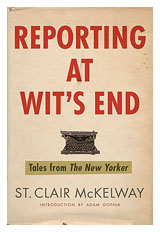Reporting at Wit’s End: Tales from The New Yorker | By St. Clair McKelway | Bloomsbury | 619 pages, $18
It’s no secret that New Yorkers nest in cramped, costly pens. The mystery concerns what else they do in those pens. Reading the largely unread St. Clair McKelway, who died in 1980, one senses that up each staircase in the Bronx and behind each door in Brooklyn, residents are performing plays of their own demented authorship. In Reporting at Wit’s End, a lovely, funny, sad collection of his work, the midcentury New Yorker writer describes a committed but talentless forger of dollar bills; a self-appointed deity; a notorious gossip writer (another sort of self-appointed deity); and, perhaps most resonantly of all, himself.
 When he focuses on the oddballs bouncing around him, McKelway hints at a grace in madness, a majesty in deceit. In piece after piece, he praises his outliers and outlaws. One counterfeiter’s bogus bills strike the author as “works of art in their way,” and he declares that “genius accompanies, like a shadow, the tread… of the dedicated imposter.” (Incidentally, that counterfeiter, who happens to enjoy ice skating, gets arrested mid-pirouette.)
When he focuses on the oddballs bouncing around him, McKelway hints at a grace in madness, a majesty in deceit. In piece after piece, he praises his outliers and outlaws. One counterfeiter’s bogus bills strike the author as “works of art in their way,” and he declares that “genius accompanies, like a shadow, the tread… of the dedicated imposter.” (Incidentally, that counterfeiter, who happens to enjoy ice skating, gets arrested mid-pirouette.)
McKelway’s own artistry—his knack for literary leaps—makes his low visibility all the more puzzling. Throughout Reporting at Wit’s End, his voice is slyly funny, subtly learned, and as slickly styled as his dark blond hair. In “Mister 880,” his riotous counterfeiting essay, McKelway reports that “the noses of the Roman counterfeiters were cut off, along with their ears and their citizenship rights.” (Rhetoric fans, take note: the author has arranged a happy marriage of anticlimax and zeugma.) An equally delightful sentence from “Who Is This King of Glory?” records the ascent of the preacher who came to call himself Father Divine, and sometimes—as the concluding parenthetical admits—something loftier: “In a mere forty years, he rose from hedge-clipper and grass-cutter to evangelist, from evangelist to The Messenger, from The Messenger to Major J. Devine, from Major J. Devine to the Rev. J. Divine, and from the Rev. J. Divine to Father Divine (God).” These small stylistic feats bring to mind Coleridge’s definition of poetry: “the best words in their best order.”
Spotting order behind apparent disorder was one of McKelway’s specialties as an analyst of the wacky. But the most extraordinary piece in this collection captures the author himself in a state of disorder that nearly defies analysis, literary or otherwise. “The Edinburgh Caper” seems at once travel essay, mystery story, and postmodern fiction, but it’s essentially autobiography: McKelway on McKelway—or on multiple McKelways.
Early in the piece, he tells an interlocutor: “Well, General, the Captain and I have pretty much come to the conclusion that I have a great many heads. I’ve counted and identified twelve separate heads, or identities, that I know I possess.”
The general and captain don’t exist. Instead, their conversation frames a story both fueled and tortured by imagination—a story that suggests McKelway may have derived some of his fascination with frauds, fools, madmen, and geniuses from the possibility that he embodied them all himself.
This capacious tale of a Scottish vacation overtaken by paranoia occupied pages 50-179 of the 1962 New Yorker where it originally appeared. (In case you haven’t sighed in the last day or so about the state of print journalism, I’ll add that a recent New Yorker consisted of eighty-three pages total.) As McKelway shepherds us through his uneventful, convoluted plot—wherein some of his multiple personalities suspect a vast conspiracy, others remain calm, and the narrator swills Scotch—we might wonder why he can’t more efficiently organize his impressions. But “The Edinburgh Caper” is about the inability to sort experience, to differentiate between the fabricated and the real. Hence its personal bravery, its deep peculiarity, and its literary fascination.
Like all accounts given by lunatics—think Lolita, or Going Rogue—“The Edinburgh Caper” pulls us into a complicated relationship with its narrator. Do we believe McKelway’s paranoid “heads,” or his calmer ones? (Either way, should we feel concerned that our narrator has more than one head?) The author compromises his credibility so profoundly that I wondered whether he’d invented the trip to Edinburgh itself. Is the “Caper,” along with the apparent insanity of its narrator, pure fiction?
Adam Gopnik’s generally illuminating introduction provides little guidance on that question. In fact, he sidesteps the whole issue of McKelway’s mental illness—even as the book’s title alludes to another piece on paranoia, “That Was a Reporter at Wit’s End.” Perhaps the author’s instability, which grew progressively severe as he aged, enabled not only the strange achievement of “The Edinburgh Caper” but also his delicate, sympathetic portraits of his fellow eccentrics. He wrote of his counterfeiter, “Although his point of view was unusual, there was certainly some sense in it.” Locating sense in nonsense may have been McKelway’s greatest gift: out of oddness, he crafted a most unusual art.
Click here for a complete Page Views archive.
Abigail Deutsch is a writer who lives in New York. Her work appears in The Village Voice, n+1, Bookforum, Poetry, and other publications.
